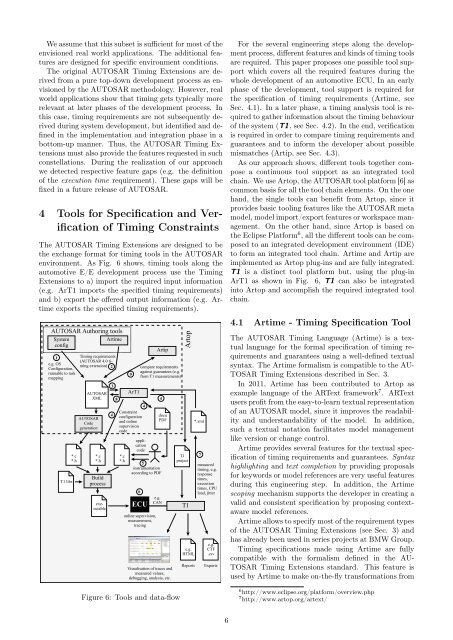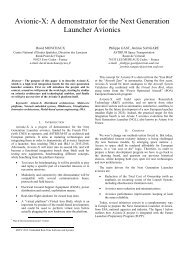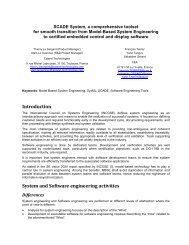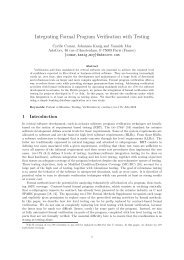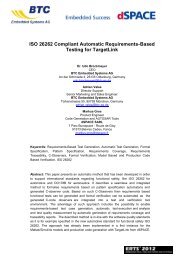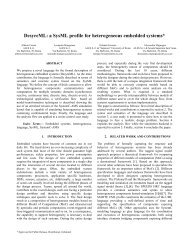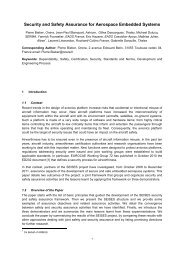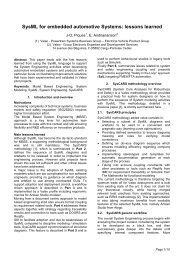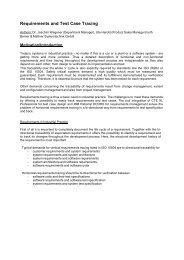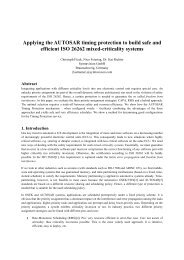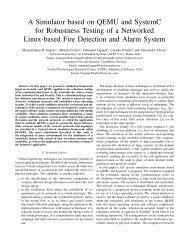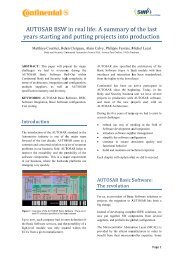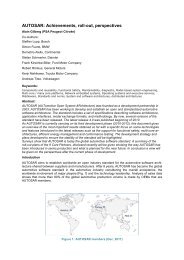Tool Support for Seamless System Development based on ...
Tool Support for Seamless System Development based on ...
Tool Support for Seamless System Development based on ...
You also want an ePaper? Increase the reach of your titles
YUMPU automatically turns print PDFs into web optimized ePapers that Google loves.
We assume that this subset is sufficient <str<strong>on</strong>g>for</str<strong>on</strong>g> most of the<br />
envisi<strong>on</strong>ed real world applicati<strong>on</strong>s. The additi<strong>on</strong>al features<br />
are designed <str<strong>on</strong>g>for</str<strong>on</strong>g> specific envir<strong>on</strong>ment c<strong>on</strong>diti<strong>on</strong>s.<br />
The original AUTOSAR Timing Extensi<strong>on</strong>s are derived<br />
from a pure top-down development process as envisi<strong>on</strong>ed<br />
by the AUTOSAR methodology. However, real<br />
world applicati<strong>on</strong>s show that timing gets typically more<br />
relevant at later phases of the development process. In<br />
this case, timing requirements are not subsequently derived<br />
during system development, but identified and defined<br />
in the implementati<strong>on</strong> and integrati<strong>on</strong> phase in a<br />
bottom-up manner. Thus, the AUTOSAR Timing Extensi<strong>on</strong>s<br />
must also provide the features requested in such<br />
c<strong>on</strong>stellati<strong>on</strong>s. During the realizati<strong>on</strong> of our approach<br />
we detected respective feature gaps (e.g. the definiti<strong>on</strong><br />
of the executi<strong>on</strong> time requirement). These gaps will be<br />
fixed in a future release of AUTOSAR.<br />
4 <str<strong>on</strong>g>Tool</str<strong>on</strong>g>s <str<strong>on</strong>g>for</str<strong>on</strong>g> Specificati<strong>on</strong> and Verificati<strong>on</strong><br />
of Timing C<strong>on</strong>straints<br />
The AUTOSAR Timing Extensi<strong>on</strong>s are designed to be<br />
the exchange <str<strong>on</strong>g>for</str<strong>on</strong>g>mat <str<strong>on</strong>g>for</str<strong>on</strong>g> timing tools in the AUTOSAR<br />
envir<strong>on</strong>ment. As Fig. 6 shows, timing tools al<strong>on</strong>g the<br />
automotive E/E development process use the Timing<br />
Extensi<strong>on</strong>s to a) import the required input in<str<strong>on</strong>g>for</str<strong>on</strong>g>mati<strong>on</strong><br />
(e.g. ArT1 imports the specified timing requirements)<br />
and b) export the offered output in<str<strong>on</strong>g>for</str<strong>on</strong>g>mati<strong>on</strong> (e.g. Artime<br />
exports the specified timing requirements).<br />
Figure 6: <str<strong>on</strong>g>Tool</str<strong>on</strong>g>s and data-flow<br />
6<br />
For the several engineering steps al<strong>on</strong>g the development<br />
process, different features and kinds of timing tools<br />
are required. This paper proposes <strong>on</strong>e possible tool support<br />
which covers all the required features during the<br />
whole development of an automotive ECU. In an early<br />
phase of the development, tool support is required <str<strong>on</strong>g>for</str<strong>on</strong>g><br />
the specificati<strong>on</strong> of timing requirements (Artime, see<br />
Sec. 4.1). In a later phase, a timing analysis tool is required<br />
to gather in<str<strong>on</strong>g>for</str<strong>on</strong>g>mati<strong>on</strong> about the timing behaviour<br />
of the system (T1, see Sec. 4.2). In the end, verificati<strong>on</strong><br />
is required in order to compare timing requirements and<br />
guarantees and to in<str<strong>on</strong>g>for</str<strong>on</strong>g>m the developer about possible<br />
mismatches (Artip, see Sec. 4.3).<br />
As our approach shows, different tools together compose<br />
a c<strong>on</strong>tinuous tool support as an integrated tool<br />
chain. We use Artop, the AUTOSAR tool plat<str<strong>on</strong>g>for</str<strong>on</strong>g>m [6] as<br />
comm<strong>on</strong> basis <str<strong>on</strong>g>for</str<strong>on</strong>g> all the tool chain elements. On the <strong>on</strong>e<br />
hand, the single tools can benefit from Artop, since it<br />
provides basic tooling features like the AUTOSAR meta<br />
model, model import/export features or workspace management.<br />
On the other hand, since Artop is <str<strong>on</strong>g>based</str<strong>on</strong>g> <strong>on</strong><br />
the Eclipse Plat<str<strong>on</strong>g>for</str<strong>on</strong>g>m 6 , all the different tools can be composed<br />
to an integrated development envir<strong>on</strong>ment (IDE)<br />
to <str<strong>on</strong>g>for</str<strong>on</strong>g>m an integrated tool chain. Artime and Artip are<br />
implemented as Artop plug-ins and are fully integrated.<br />
T1 is a distinct tool plat<str<strong>on</strong>g>for</str<strong>on</strong>g>m but, using the plug-in<br />
ArT1 as shown in Fig. 6, T1 can also be integrated<br />
into Artop and accomplish the required integrated tool<br />
chain.<br />
4.1 Artime - Timing Specificati<strong>on</strong> <str<strong>on</strong>g>Tool</str<strong>on</strong>g><br />
The AUTOSAR Timing Language (Artime) is a textual<br />
language <str<strong>on</strong>g>for</str<strong>on</strong>g> the <str<strong>on</strong>g>for</str<strong>on</strong>g>mal specificati<strong>on</strong> of timing requirements<br />
and guarantees using a well-defined textual<br />
syntax. The Artime <str<strong>on</strong>g>for</str<strong>on</strong>g>malism is compatible to the AU-<br />
TOSAR Timing Extensi<strong>on</strong>s described in Sec. 3.<br />
In 2011, Artime has been c<strong>on</strong>tributed to Artop as<br />
example language of the ARText framework 7 . ARText<br />
users profit from the easy-to-learn textual representati<strong>on</strong><br />
of an AUTOSAR model, since it improves the readability<br />
and understandability of the model. In additi<strong>on</strong>,<br />
such a textual notati<strong>on</strong> facilitates model management<br />
like versi<strong>on</strong> or change c<strong>on</strong>trol.<br />
Artime provides several features <str<strong>on</strong>g>for</str<strong>on</strong>g> the textual specificati<strong>on</strong><br />
of timing requirements and guarantees. Syntax<br />
highlighting and text completi<strong>on</strong> by providing proposals<br />
<str<strong>on</strong>g>for</str<strong>on</strong>g> keywords or model references are very useful features<br />
during this engineering step. In additi<strong>on</strong>, the Artime<br />
scoping mechanism supports the developer in creating a<br />
valid and c<strong>on</strong>sistent specificati<strong>on</strong> by proposing c<strong>on</strong>textaware<br />
model references.<br />
Artime allows to specify most of the requirement types<br />
of the AUTOSAR Timing Extensi<strong>on</strong>s (see Sec. 3) and<br />
has already been used in series projects at BMW Group.<br />
Timing specificati<strong>on</strong>s made using Artime are fully<br />
compatible with the <str<strong>on</strong>g>for</str<strong>on</strong>g>malism defined in the AU-<br />
TOSAR Timing Extensi<strong>on</strong>s standard. This feature is<br />
used by Artime to make <strong>on</strong>-the-fly trans<str<strong>on</strong>g>for</str<strong>on</strong>g>mati<strong>on</strong>s from<br />
6 http://www.eclipse.org/plat<str<strong>on</strong>g>for</str<strong>on</strong>g>m/overview.php<br />
7 http://www.artop.org/artext/


